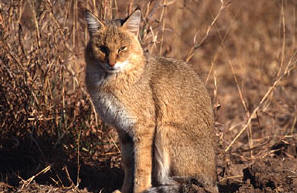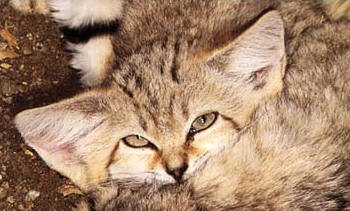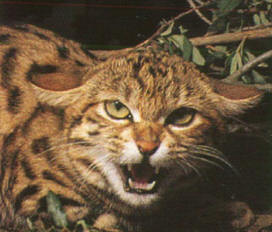| Genus Felis The Jungle Cat (Felis chaus) is found on three continents if Europe is considered and has one of the widest distributions of any wild cat. But the jungle cat is, as the photo shows, is not a cat of the jungle but rather of grasslands. It is a terrestrial hunter with its long legs as evidence. Its diet varies with the location but generally it eats rodents, lizards, frogs, fish, insects, deer fawns and poultry. |
 |
| The Sand Cat (Felis margarita) is a five pound hardy little kitty. Being native to African and Asian deserts has forced this cat to be tough. Like the fennec fox of the area this cat is equipped with large ears to lose heat on the hot desert days. Also large ears gives them the edge on prey detection under the sandy sediment. They eat jerboas, sand voles, hares, and other burrowers along with birds, reptiles and insects. They are able to get all the moisture they need from their prey. |  |
| The Black-Footed Cat (Felis nigripes) is the smallest cat in Africa and one of the smallest in general. It has been said that it could kill a giraffe which is obviously a tall tale yet this four pound cat can look very ferocious when the ears flatten. These cats are named for the black fur under each paw which protects them from the hot sand. To stay out of the piercing sun light of day these little carnivores hunt at night and hide in the shadow of termite mounds or in old aardvark burrows by day. They can live without water for a long time by their diet's moisture. They eat rodents, spiders, and insects. |
|
| The Wildcat (Felis silvestris) is found in Africa Asia and Europe but it was the African individuals that gave rise to the Domestic cat. And it is the African ones that look most like the house cat. Just look at your tabby and you see the wildcat markings. It was said to be the Ancient Egyptians that did the domesticating. Many scientists say that the domestic cat is just a another subspecies of the wildcat. But wildcat stock is not too pure any more after domestic cat hybridizations. |
 |
